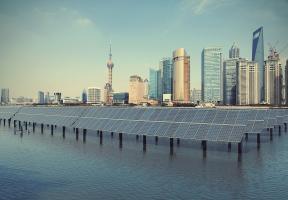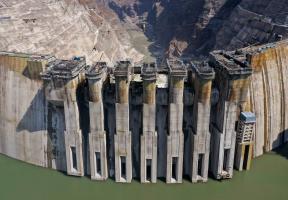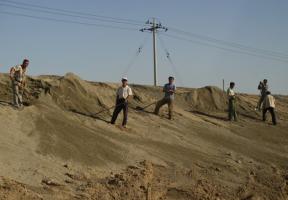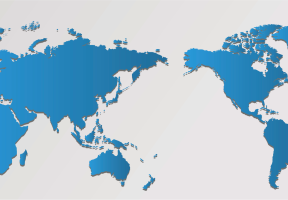Potential Arctic Routes
5 min read
The summer retreat of Arctic sea ice, linked to , is gradually making two sea routes across the Arctic Ocean viable, connecting the Atlantic and Pacific oceans. These passages, accessible for a few weeks in summer, are attracting growing interest due to their geopolitical and economic implications.
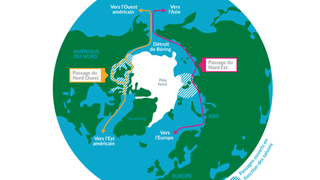
© 5ème Gauche - Skeleton map showing the northwest (orange) and northeast (red) sea lanes. The shaded areas are the regions that are sometimes free of ice, depending on the season.
The Northwest Passage and the Northern Sea Route
The reduction in the extent of Arctic sea ice in summer has multiple consequences. These include: contributing to the rise in average sea levels, the potential release of methane (a greenhouse gas (GHG) with a high global warming potential) trapped in , changes in ocean currents, and finally impacts on marine and associated ecosystems.
But this seasonal decline in sea ice also has geopolitical and economic implications: it gradually opens new shipping routes in the Arctic Ocean that could supplement the traditional corridors of the Cape of Good Hope, the Suez Canal, the Strait of Malacca, and the Panama Canal.
These two routes are located east and west of the North Pole:
- The Northwest Passage: 1,500 km long, it skirts the Arctic islands of Canada's far north, runs along the US state of Alaska, and empties into the Pacific Ocean via the Bering Strait, which is 85 km wide and separates US and Russian territory. The Northwest Passage, which is sometimes blocked by ice throughout the year, has still been used very little, with only a few merchant ships having traveled through it since 1969.
- The Northern Sea Route: starts at the Barents Sea, crosses the Russian Archipelago known as Severnaya Zemlya (Northern Land), runs along the coast of eastern Siberia, and joins the Pacific Ocean via the same Bering Strait. Since 2010, maritime traffic has increased significantly, with a record 35 million tons transported in 2023 (compared, for example, to the 1.6 billion tons that passed through the Suez Canal in the same year).
These two passages present numerous difficulties. In addition to the problem of ice that can immobilize ships for months, they include straits that are only a few dozen feet deep, sometimes less.
The Long History of the Conquest of the Arctic
As early as the 10th century, Vikings settled in Greenland began to travel around the Canadian Arctic Archipelago. But it was not until the great European explorations of the 16th century that the first attempts were made to find passages to China and India. In 1575, Martin Frobischer ventured into the Baffin Sea to the West. But it was not until 1879 that the the more navigable Northern Sea Route was opened on the Russian side, and 1906 before Roald Amundsen inaugurated the Northwest Passage on the Canadian side.
Exploring the Arctic has its share of tragedies. The Franklin expedition, with two ships, the Erebus and the Terror, set sail in 1845 for Baffin Bay. The ships became trapped in ice, and the 135 crew members set out on foot and died of hypothermia, scurvy, and starvation. The wrecks of the Erebus and Terror were found in 2014 and 2016, respectively!
Opportunities and Limitations of Arctic Routes
The summer melting of sea ice, driven by global warming, makes these routes more accessible. Some see logistical opportunities: shorter journeys could reduce travel time and consumption on certain routes between Europe and Asia. However, these advantages remain seasonal and come with significant environmental and geopolitical risks.
The Arctic Council emphasizes that increased maritime traffic can disrupt ecosystems and local communities, as well as heighten the risk of pollution, particularly from fuels such as . This paradox—a worrying climate phenomenon creating effects that appear favorable in the short term—raises questions about the trade-offs between economic interests and climate goals.
Geopolitical Constraints
The opening of these routes is not limited to economic issues: it is also reigniting geopolitical tensions, particularly between the United States, Russia, and China. Russia is seeking to control civil and military traffic through its port facilities and the navigation rules it has enacted, China is increasing its commercial presence, while the United States has expressed territorial claims over Greenland. These rivalries fall within an international legal framework—the —but they illustrate the complexity of Arctic governance. The Arctic Council emphasizes the need for cooperation to prevent these routes from becoming areas of confrontation.
Technical and Weather Obstacles
Even in summer, these routes remain challenging due to drifting ice, fog, inaccurate nautical charts, and limited infrastructure. Ships must be specially designed for navigation in icy conditions and comply with the strict standards of the International Maritime Organization (IMO) . The costs associated with icebreakers, insurance, and emergency rescue are very high, limiting their use to specialized operations. The Arctic Council notes that the navigable season remains short and that environmental risks (such as pollution and accidents) are amplified by the isolation and fragility of ecosystems.


